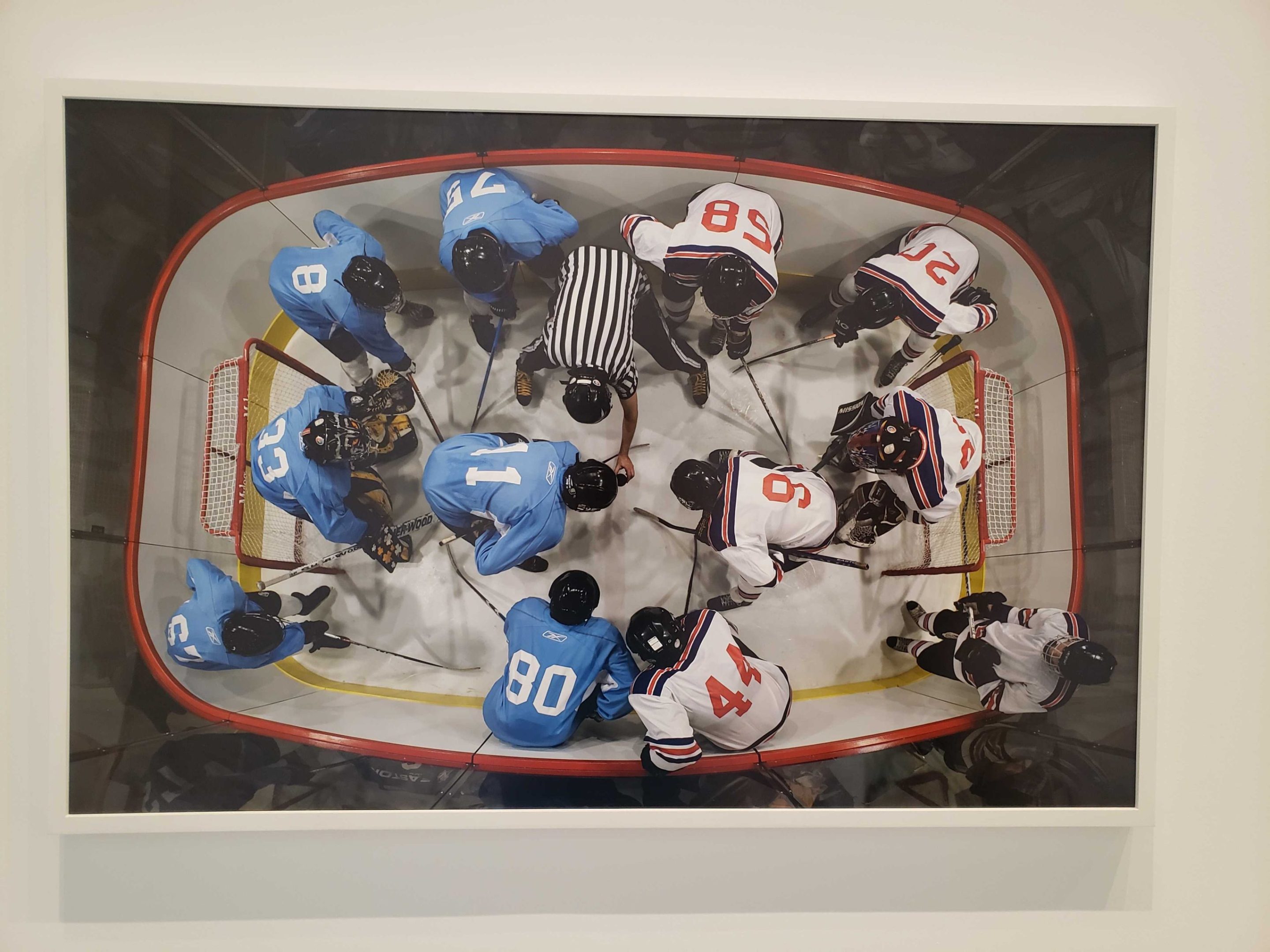Every museum should have a little nook for the jocks. That's what I decided at the very end of my trip to Austin, Texas's Blanton Museum of Art when I saw the work of R. Eric McMaster on display. Outside the screening room were three pieces that all asked the viewer to recontextualize the way they look at sports. There was this colorful aerial photo of a rugby scrum and a sculpture piece that combined two football helmets at the face mask. (Kiss!) The third was another photograph called The Obstruction of Action by the Existence of Form. I snapped a pic because it sparked my brain, the way it shoved all the visuals of a wide-open sport into a rink the size of a jacuzzi. The colors and perspective alone caught my eye—the contrast of light blue facing white, the zebra interruption in the upper center, the way the playing area appears almost convex as it dominates its participants rather than the more traditional reverse. It's a fun and memorable photo, but wait! I would quickly be delighted to learn that there's more.
There were three short films on a loop in the screening room. One featured a gymnast attempting to perform a routine underwater, and another was a silent montage of Olympic athletes' faces in the moments before they began their attempts. But of course it was the third, an eight-minute realization of the photo, that reached out and grabbed me.
The 95-degree Texas weather was not at all conducive to sensations of sweaters and beanies and skates scraping against ice. But this is still a crucial time to be a fan, with high-stakes games between incredible teams happening nearly every night. Despite the Dallas Stars' success, I didn't notice signs of playoff fever anywhere in Austin. I did my best, privately, to keep up with Thursday and Friday's clutch goals, but it was only in this space that I saw any acknowledgement of hockey's existence.
I'm kind of a maniac for hockey. I'm thinking about it all the time, and especially in the spring I'm watching it almost every day. But that's a parasocial relationship. It's when I'm actually at a game, a few times a year, that I can indulge this love in three dimensions, with all the sensory treats that come with it: the chill on my arms, the sticky stairs against my boots, the feel of a beer can that's too large for my hand, the divine authority of the PA announcer, the freedom to watch the game as it happens without commentary or camera direction or commercial breaks running any interference. I'm happy when I set foot in this world. It's like being high, with less confusion.
The Film and Video Gallery at the Blanton did not provide hot dogs or red lights or the first 45 seconds of "My Own Worst Enemy" by Lit, but in a dark room with a giant screen I found a little home on the range. I leaned in, grin on my face, and gave McMaster's film my full attention.
The sound attracted me as much as the visual. There's this constant rattle of thumps and bumps, like a dryer with a pair of shoes in it, that provides the music of action even with so many restrictions on movement. The voices of the anonymous players wrap me in a welcoming embrace—determined, energetic, treating this like a serious competitive endeavor. Yes, it's kind of a cheat code to my heart for an artist to explore a subject I'm predisposed to love, but its individual pieces, broken down, provided something fresh to savor.
Just how fresh is it? What is it we're watching, exactly? It's hockey, you suppose, but it looks nothing like any hockey you've ever watched, so ... what? Do the same actions carry the same significance even in a drastically warped venue? What does it say about humans that we stick to the familiar routines no matter what happens to our environment? Are rules so important that they can't be tweaked for unique cases? Those are big questions to chew on, and maybe some are a reach, because the piece could also just be asking, Hey, what if we did some hockey on a tiny rink and pretended it was normal?
I usually think of hockey as an unchanging beast, and I take some comfort in that consistency. Every hockey game looks like every hockey game. Nobody has ever turned one on or stepped through a curtain at a rink and been shocked to see, like, dirt in the crease or a third net on triangle-shaped ice. But when I try harder, I think about all the ways I've engaged with this sport beyond the Platonic ideal of it. There's 3-on-3 hockey on borrowed skates in a backyard rink, snow shovels playing the role of goalie as they sit propped against the crossbar. There's driveway hockey with the unpredictable bounces of an orange ball, faceoffs administered by two players on roller blades tapping sticks three times. There's dome hockey and air hockey and video-game hockey and the action-figure hockey I puppeteered as a child. There's basement mini-sticks with tiny plastic nets and rug burns. All are actions that we recognize as hockey—not obstructed by form, but defining it. A 200-foot rink doesn't make hockey. Hockey makes hockey.






